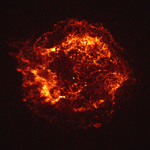Cassiopeia A (Cas A) is the 320 year old remnant of a massive star that exploded. The Chandra X-ray image made with the Advanced CCD Imaging Spectrometer (ACIS) shows an expanding shell of hot gas produced by the explosion. This gaseous shell is about 10 light years in diameter, and has a temperature of about 50 million degrees.
The material from the explosion is rushing outward at supersonic speeds in excess of ten million miles per hour. As this matter crashes into gas that surrounds the former star, shock waves analogous to awesome sonic booms heat the gas and heat the ejected matter.
The Cas A Supernova
A supernova occurs when a massive star has used up its nuclear
fuel and the pressure drops in the central core of the star. The
matter in the core is crushed by gravity to higher and higher
densities, and temperatures reach billions of degrees. Under
these extreme conditions, nuclear reactions occur violently and
catastrophically reversing the collapse. A thermonuclear shock
wave races through the now expanding stellar debris, fusing
lighter elements into heavier ones and producing a brilliant
visual outburst.
About every fifty years in our galaxy, a massive star explodes. The shell of matter thrown off by the supernova creates a bubble of multi-million degree gas called a supernova remnant. Cas A is a prime example. The hot gas will expand and produce X-rays for thousands of years.
The nature of the explosion that produced Cas A has been an enigma. Although radio, optical and X-ray observations of the remnant indicate that it was a powerful event, the visual brightness of the outburst was much less than a normal supernova. Apparently Cas A was produced by the explosion of an unusual massive star that had previously ejected most of its outer layers.
Probing Cas A Mysteries with NASA's Chandra
X-ray Observatory
Chandra's spectacularly vivid images of Cas A allow scientists
to trace the dynamics of the remnant and its collision with any
material ejected by the star before it exploded. Chandra
detectors provide scientists with precise X-ray spectra–
measurements of the energies of individual X-rays–from the
Cas A remnant. These measurements make it possible to identify
which heavy elements are present and in what quantities.
Chandra's observations should help astronomers to resolve the
long-standing mystery as to the nature and origin of Cas
A.
A related mystery is whether the explosion that produced Cas A left behind a neutron star, black hole, or nothing at all. This "First Light" Chandra image of Cas A shows a bright object near the center of the remnant! Longer observations with Chandra can determine if this is the long sought for neutron star or black hole.
Importance of Supernova
The study of remnants of exploded stars, or supernovas, is
essential for our understanding of the origin of life on Earth.
The cloud of gas and dust that collapsed to form the Sun, Earth
and other planets was composed mostly of hydrogen and helium,
with a small amount of heavier elements such as carbon,
nitrogen, oxygen and iron. The only place where these and other
heavy elements necessary for life are made, is deep in the
interior of a massive star. There they remain until a
catastrophic explosion spreads them throughout space.
Supernovae are the creative flashes that renew the galaxy. They seed the interstellar gas with heavy elements, heat it with the energy of their radiation, stir it up with the force of their blast waves and cause new stars to form.
[ Press Index ] [ Fact Sheets ]


